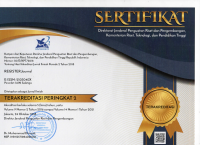Reconstructing language curriculum in the digital era: A qualitative study on the role of technology in transforming learning
Abstract
In the midst of rapid digital transformation, language education faces the urgent need to redesign curricula that align with technological advancements while ensuring inclusivity. This study aims to investigate how technology facilitates the reconstruction of language curricula in urban Indonesian contexts. Employing a qualitative multi-site case study design, data were collected from 15 language teachers across eight schools in South Jakarta and South Tangerang between August and October 2024 through semi-structured interviews, classroom observations, and document analysis. Thematic analysis revealed three major findings: (1) technological adaptation varied by region, with South Jakarta schools integrating advanced tools such as AI-powered applications, while South Tangerang relied on basic platforms due to infrastructural constraints; (2) pedagogical shifts toward learner-centered approaches were more evident in well-resourced schools, supported by collaborative digital tools; and (3) inclusivity efforts, including smartphone-based activities and bilingual resources, were hindered by socioeconomic disparities and unstable internet access. The study concludes that while technology holds transformative potential for language education, its impact is constrained by resource inequities, highlighting the need for targeted teacher training and equitable infrastructure investment. These findings contribute to the limited Southeast Asian literature on technology-enhanced curriculum design and offer practical implications for policymakers and educators in developing contexts.
Keywords
Full Text:
PDFReferences
Adams, W. C. (2015). Conducting Semi‐Structured Interviews. In Handbook of Practical Program Evaluation (pp. 492–505). Wiley. https://doi.org/10.1002/9781119171386.ch19
Baxter, P., & Jack, S. (2015). Qualitative Case Study Methodology: Study Design and Implementation for Novice Researchers. The Qualitative Report. https://doi.org/10.46743/2160-3715/2008.1573
Birt, L., Scott, S., Cavers, D., Campbell, C., & Walter, F. (2016). Member Checking. Qualitative Health Research, 26(13), 1802–1811. https://doi.org/10.1177/1049732316654870
Braun, V., & Clarke, V. (2006). Using thematic analysis in psychology. Qualitative Research in Psychology, 3(2), 77–101. https://doi.org/10.1191/1478088706qp063oa
British Educational Research Association. (2018). Ethical guidelines for educational research (4th ed.).
Carter, N., Bryant-Lukosius, D., DiCenso, A., Blythe, J., & Neville, A. J. (2014). The Use of Triangulation in Qualitative Research. Oncology Nursing Forum, 41(5), 545–547. https://doi.org/10.1188/14.ONF.545-547
Cohen, L., Manion, L., & Morrison, K. (2017). Research Methods in Education. Routledge. https://doi.org/10.4324/9781315456539
Creswell, J. W., & Poth, C. N. (2018). Qualitative inquiry and research design: Choosing among five approaches (4th ed.). SAGE Publications.
Dudeney, G., & Hockly, N. (2016). Literacies, technology and language teaching. In F. Farr & L. Murray (Eds.), The Routledge handbook of language learning and technology (pp. 115–126). Routledge.
Etikan, I. (2016). Comparison of Convenience Sampling and Purposive Sampling. American Journal of Theoretical and Applied Statistics, 5(1), 1. https://doi.org/10.11648/j.ajtas.20160501.11
Flick, U. (2018). Designing Qualitative Research. SAGE Publications Ltd. https://doi.org/10.4135/9781529622737
Fusch, P., & Ness, L. (2015). Are We There Yet? Data Saturation in Qualitative Research. The Qualitative Report. https://doi.org/10.46743/2160-3715/2015.2281
Godwin-Jones, R. (2022). Expanding and contextualizing digital language learning. Bilingualism: Language and Cognition, 25(3), 386–387. https://doi.org/10.1017/S1366728921000547
Heath, S., Charles, V., Crow, G., & Wiles, R. (2019). Informed consent, gatekeepers and go-betweens: Negotiating consent in child- and youth-orientated institutions. British Educational Research Journal, 45(1). https://doi.org/10.1002/berj.3456
Kern, R. (2014). Technology as Pharmakon : The Promise and Perils of the Internet for Foreign Language Education. The Modern Language Journal, 98(1), 340–357. https://doi.org/10.1111/j.1540-4781.2014.12065.x
Kukulska‐Hulme, A., Lee, H., & Norris, L. (2017). Mobile learning revolution: Implications for language pedagogy. In The Handbook of Technology and Second Language Teaching and Learning (pp. 217–233). Wiley. https://doi.org/10.1002/9781118914069.ch15
Lamb, M., & Arisandy, F. E. (2020). The impact of online use of English on motivation to learn. Computer Assisted Language Learning, 33(1–2), 85–108. https://doi.org/10.1080/09588221.2018.1545670
Lantolf, J. P., & Poehner, M. E. (2014). Sociocultural Theory and the Pedagogical Imperative in L2 Education. Routledge. https://doi.org/10.4324/9780203813850
Merriam, S. B., & Grenier, R. S. (Eds.). (2019). Qualitative Research in Practice: Examples for Discussion and Analysis, 2nd Edition. Jossey-Bass.
Muhaimin, Asrial, Habibi, A., Mukminin, A., & Hadisaputra, P. (2020). Science teachers’ integration of digital resources in education: A survey in rural areas of one Indonesian province. Heliyon, 6(8), e04631. https://doi.org/10.1016/j.heliyon.2020.e04631
Nowell, L. S., Norris, J. M., White, D. E., & Moules, N. J. (2017). Thematic Analysis. International Journal of Qualitative Methods, 16(1). https://doi.org/10.1177/1609406917733847
Palinkas, L. A., Horwitz, S. M., Green, C. A., Wisdom, J. P., Duan, N., &
Hoagwood, K. (2015). Purposeful Sampling for Qualitative Data Collection and Analysis in Mixed Method Implementation Research. Administration and Policy in Mental Health and Mental Health Services Research, 42(5), 533–544. https://doi.org/10.1007/s10488-013-0528-y
Selwyn, N. (2016). Digital downsides: exploring university students’ negative engagements with digital technology. Teaching in Higher Education, 21(8), 1006–1021. https://doi.org/10.1080/13562517.2016.1213229
Shadiev, R., & Yang, M. (2020). Review of Studies on Technology-Enhanced Language Learning and Teaching. Sustainability, 12(2), 524. https://doi.org/10.3390/su12020524
Tight, M. (2019). Documentary Research in the Social Sciences. SAGE Publications Ltd. https://doi.org/10.4135/9781529716559
Vaismoradi, M., & Snelgrove, S. (2019). Theme in Qualitative Content Analysis and Thematic Analysis. https://doi.org/https://doi.org/10.17169/fqs-20.3.3376
Vygotsky, L. S. (1980). Interaction between Learning and Development. In Mind in Society (pp. 79–91). Harvard University Press. https://doi.org/10.2307/j.ctvjf9vz4.11
Widodo, H. P. (2016). Language Policy in Practice: Reframing the English Language Curriculum in the Indonesian Secondary Education Sector (pp. 127–151). https://doi.org/10.1007/978-3-319-22464-0_6
Widodo, H. P., Fang, F., & Elyas, T. (2020). The construction of language teacher professional identity in the Global Englishes territory: ‘we are legitimate language teachers.’ Asian Englishes, 22(3), 309–316. https://doi.org/10.1080/13488678.2020.1732683
Yazan, B. (2015). Three Approaches to Case Study Methods in Education: Yin, Merriam, and Stake. The Qualitative Report. https://doi.org/10.46743/2160-3715/2015.2102
Zhang, R., & Zou, D. (2022). Types, purposes, and effectiveness of state-of-the-art technologies for second and foreign language learning. Computer Assisted Language Learning, 35(4), 696–742. https://doi.org/10.1080/09588221.2020.1744666
DOI: https://dx.doi.org/10.30659/e.10.2.377-394
Refbacks
- There are currently no refbacks.
Copyright (c) 2025 Deny Gunawan Susandi, Lili Wahdini, Siti Rodiyah, Irna Sjafei, Dadi Waras Suhardjono
License URL: https://creativecommons.org/licenses/by/4.0/










